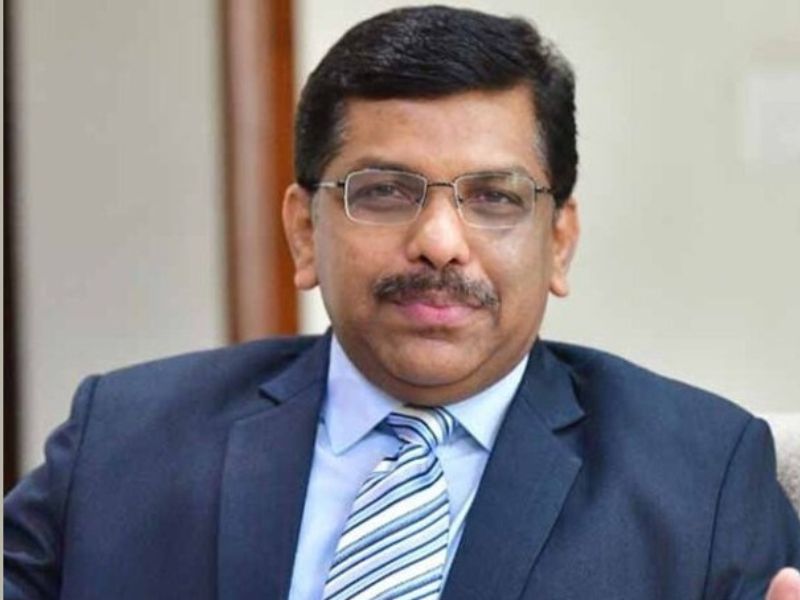It’s a tragedy that the great international institution christened Visva-Bharati (India-World) University in which literature Nobel laureate Rabindranath Tagore invested the “cargo of my life’s best treasure” and which he gifted to India, has been reduced to the status of a provincial university. Reports Gargi Banerjee with Dilip Thakore
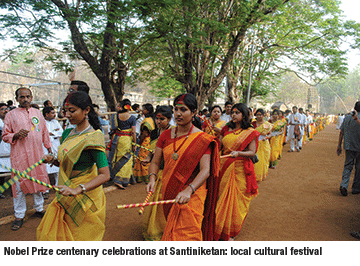 The recently-concluded year 2013, especially November 14, was a landmark date for the Visva-Bharati University, Santiniketan (VBU, estb. 1921) which sprawls across 1,127 acres in the Bolpur municipality of Birbhum district (West Bengal), 180 km by road from the colonial metropolis of Kolkata (formerly Calcutta). In the leafy groves of VBU, the university’s 8,000 students, 604 faculty and residents of the town of Santiniketan (pop.300,000) staged year-long celebrations to mark the centenary of the Nobel Prize for Literature 1913 awarded to VBU’s legendary founder — poet, essayist, painter and educator Rabindranath Tagore (1861-1941) — the first Asian and (non-European) to receive the Nobel for his anthology of poems titled Gitanjali: Song of Offerings. Translated from Bengali into English by Tagore himself in 1912, it was published with some help from the legendary Irish poet William Butler Yeats later that year.
The recently-concluded year 2013, especially November 14, was a landmark date for the Visva-Bharati University, Santiniketan (VBU, estb. 1921) which sprawls across 1,127 acres in the Bolpur municipality of Birbhum district (West Bengal), 180 km by road from the colonial metropolis of Kolkata (formerly Calcutta). In the leafy groves of VBU, the university’s 8,000 students, 604 faculty and residents of the town of Santiniketan (pop.300,000) staged year-long celebrations to mark the centenary of the Nobel Prize for Literature 1913 awarded to VBU’s legendary founder — poet, essayist, painter and educator Rabindranath Tagore (1861-1941) — the first Asian and (non-European) to receive the Nobel for his anthology of poems titled Gitanjali: Song of Offerings. Translated from Bengali into English by Tagore himself in 1912, it was published with some help from the legendary Irish poet William Butler Yeats later that year.
Describing his poetry as “truly universally human in character” in the following year, the Nobel jury conferred its highest prize to Tagore “because of his profoundly sensitive, fresh and beautiful verse, by which, with consummate skill, he has made his poetic thought, expressed in his own English words, a part of the literature of the West”. Invested with the poet’s lofty philosophy, embracing humanism and brilliant English language vocabulary, Gitanjali took Europe by storm. Ten editions were published in six months and Rabindranath Tagore was transformed into a global icon.
Although President Pranab Mukherjee, while on his first visit to his hometown of Mirati in Birbhum district after his unexpected elevation to Rashtrapati Bhavan, New Delhi in 2012, formally inaugurated VBU’s celebrations in Santiniketan on December 18, 2012 by releasing a special centenary edition of Gitanjali, curiously the year-long commemoration remained a local festival featuring a series of cultural programmes and lectures organised by various faculties of VBU.
Among the notable events staged on the VBU campus as a tribute to its multi-skilled and visionary founder were the publication of a biography of his son Rathindranath and an international seminar titled ‘Tagore Across Cultures: The Nobel Prize and Beyond’ addressed by Tan Chung, an authority on Sino-India relations (VBU started a faculty of Chinese studies in 1937) and Janus Martony, Hungary’s foreign minister. But surprisingly — indeed shockingly — beyond Santiniketan, this noteworthy event aroused minimal interest in the rest of the country, and even in neighbouring Kolkata media coverage of the year-long fest was at best cursory.
The sad truth is that Visva-Bharati, the great international institution in which this visionary savant and towering intellectual of the 20th century invested the “cargo of my life’s best treasure”, and which he gifted to the about-to-be-born nation in his last meeting with Mahatma Gandhi at Santiniketan on March 2, 1940 expressing the hope that “it may claim special care from my countrymen for its preservation”, has been reduced to the status of a provincial university. Despite its distinguished parentage — Tagore with his remarkable versatility and creative energy wrote over 50 volumes of poetry, 40 plays, 14 novels, 50 volumes of essays, 90 short stories, 14 novels, composed over 2,000 songs, created more than 2,000 paintings and sketches, and as an educator promoted the Brahmacharya Ashram School, Sriniketan rural reconstruction schools and Visva-Bharati University — this unique institution of higher education seems to have been banished from the collective conscious of the 300 million strong Indian middle class.
Although Viswa-Bharati boasts a handful of distinguished alumni including former prime minister Indira Gandhi, Nobel laureate economist Amartya Sen, and the late iconic film director Satyajit Ray who all sojourned briefly in VBU, today there are very few except Bengal sub-nationalists ready to sing its praises. In the annual league table of India’s Best Universities 2013 published by India Today, VBU doesn’t make it into the Top 10, weighing in at #14 below Andhra and Kurukshetra universities. In 2012 it was ranked #26.
The genesis of VBU can be traced back to 1901 when Gurudev (“revered teacher”) as Tagore was respectfully known, started a primary school named the Bramhacharya Ashram with five students in Santiniketan. Although the bard had no formal training as an educator, unlike most of his contemporaries and political leaders of the time, Tagore believed that culturally rooted education was essential for national development and resurgence and — again unlike the country’s indolent intellectuals before and since — gave practical shape and form to his ideas. Disenchanted with the British public and colonial school system — he was sent to Sherbourne College in the UK but dropped out quickly to resume his self-education — long before it became fashionable to do so (like his contemporary J. Krishnamurti who founded the Rishi Valley School, Chittoor in 1926), Tagore dreamed of establishing an alternative system of education which would nurture the creativity of every child.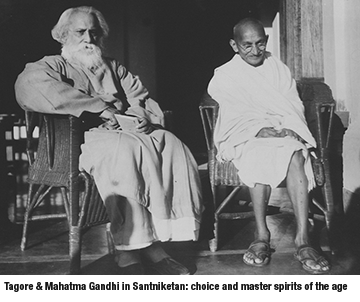
In Santiniketan (‘abode of peace’), Gurudev innovated an education system based on India’s time-honoured ashram tradition, where every student shorn of luxury would be raised to become a self-dependent individual. However, drawing upon the work and thinking of educationists in the West, he rejected learning by rote and propagated it as a joyous process in close communion with nature that would enable children to flower into self reliant human beings. He advocated nurturance of the naturally creative minds of children, so that their creativity could soar beyond “dull text books” and school walls. Moreover, he wanted the process of knowledge dissemination to be joyful not just for students but for teachers as well.
Unappreciated and forgotten today by an ungrateful nation, which practising crass materialism under the guise of socialism has run India’s once venerated education system into the ground, Tagore the educator was a man far ahead of his time. In her extraordinarily researched and enlightening biography Rabindranath Tagore — The Poet as Educator (Visva-Bharati, 2002), Kathleen M. O’Connell groups Tagore with great “progressive-humanist educationists” such as Maria Montessori, John Dewey, Rudolph Steiner, Daniel Goleman and Dr. Howard Gardner. “While many educators share a number of Tagore’s concerns and have implemented them in their educational schemes, it is hard to find another artist-educator of Tagore’s stature who exhibits an equivalent holistic ability to think in such a creative and far-reaching manner amidst multi-racial, multi-lingual and multi-cultural situations,” writes O’Connell.
O’Connell’s high opinion of Tagore as an educator formed after deep research into his life and voluminous works, is shared by Bangalore-based Ramachandra Guha, India’s most respected contemporary historian. In his excellent compendium Makers of Modern India (Viking/Penguin, 2010), Guha describes Tagore as a “patriot without being a nationalist”, who believed that India “had much to learn from other cultures, including (but not restricted to) the West”. “The curriculum that he developed here (VBU) bridged science and the humanities. Music and art was also taught and there was special focus on the study of Japan and China, the two civilisations with which India might, in Tagore’s view, share mutually beneficial interactions in a post-colonial future,” writes Guha.
Certainly Visva-Bharati which admitted its first batch of students in 1921, was an international university by 1924. According to O’Connell, at that time “students and staff came from different parts of India and the world” with Tagore, C.F. (Deenabandhu) Andrews and missionary-educationist W.W. Pearson teaching English literature, and Gurudev himself doubling as biology teacher. “A sampling of scholars who taught Western subjects included Hirjibhai Pestonjee Maurice, a Parsi from Bombay who taught French and English; Narsinhbhai Patel, a Gujarati from East Africa who taught German; Jehangir Bakil, an Oxford graduate who taught English and philosophy and was principal of Siksha Bhavan. Vincent Lesny (of the Charles University) taught German and M. Ferdinand Benoit came from Switzerland to teach French. Sir Patrick Geddes visited Santiniketan in 1922 and created a plan for the layout of Santiniketan and Sriniketan, while his son Arthur worked at Sriniketan. Among those joining in the 1930s were Alex Aronson who came as lecturer in English, and Marjorie Sykes, a Quaker who served in various capacities at Santiniketan and Sriniketan and later worked with Gandhi at Wardha,” writes O’Connell in Tagore: The Poet as Educator.
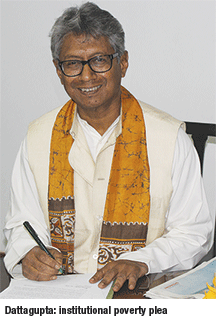 Yet despite its brilliant conceptualisation and flying start, Tagore’s great dream of a global institution of higher education offering the ancient wisdom of the orient mixed with the scientific advancements of the West — separate and distinct from the great universities of Oxford and Cambridge which he irreverently described as “hard boiled eggs from which you cannot expect chickens to come out” — is nowhere near realisation. Today VBU is a ghost of the past, a university whose autonomy has been constricted “within narrow domestic walls” by the University Grants Commission (Visva-Bharati became a Central government-funded institution after Parliament passed the Visva-Bharati Act, 1951 and came under the jurisdiction of the University Grants Commission when the commission was constituted in 1956 to licence and supervise all universities countrywide).
Yet despite its brilliant conceptualisation and flying start, Tagore’s great dream of a global institution of higher education offering the ancient wisdom of the orient mixed with the scientific advancements of the West — separate and distinct from the great universities of Oxford and Cambridge which he irreverently described as “hard boiled eggs from which you cannot expect chickens to come out” — is nowhere near realisation. Today VBU is a ghost of the past, a university whose autonomy has been constricted “within narrow domestic walls” by the University Grants Commission (Visva-Bharati became a Central government-funded institution after Parliament passed the Visva-Bharati Act, 1951 and came under the jurisdiction of the University Grants Commission when the commission was constituted in 1956 to licence and supervise all universities countrywide).
Although ex facie VBU’s 1,127 acre campus presents an idyllic vista of lush greenery with numerous landmarks favoured by Tagore such as amra kunja (mango grove), bakul bithi (paths lined by bakula trees) and saal bithi standing tall amid colourful dahlias and marigolds in full bloom, signs of institutional poverty are visible. Many of the buildings on campus are in rundown condition with wilting infrastructure.
This is unsurprising given that the UGC’s annual grant to VBU with its complement of 8,000 students and 604 faculty is a mere Rs.16.09 crore per year. Moreover in conformity with the ill-advised tradition of publicly funded higher education institutions countrywide, tuition fees are rock bottom ranging from Rs.2,495-9,260 per annum and contribute a mere 2.06 percent of VBU’s aggregate annual expenditure of Rs.14.38 crore.
“Even during his lifetime, Gurudev spent a third of time worrying about finances to run this university of his dreams. Though Tagore’s many benevolent friends contributed generously to build the university, he had to travel abroad extensively to raise funds. Despite his best efforts, the financial crunch remained till his dying day. Unfortunately things haven’t changed even decades after his death,” rues Sushanta Dattagupta, vice chancellor of VBU. An alumnus of Presidency College, Kolkata and St. John’s University, New York, Dattagupta served with JNU and IISER, before being appointed VC in November 2011.
Visva Bharati’s precarious financial condition — a fate it shares with all public funded universities because populist governments dare not permit tuition fees to be raised — apart, even the academic reputation of this 92-year-old university has steadily declined. Ever since VBU sought and accepted the all-important ‘recognition’ of the University Grants Commission — a precondition of Central or state government largesse — the commission has imposed its pedestrian one-size-fits-all syllabuses and curriculums upon the varsity. Over the past six decades, this faustian bargain has had the effect of severely eroding its once famous autonomy — particularly the academic innovations and free-thinking for which it was famous in its early years.
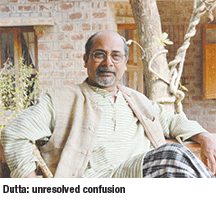 Moreover, even to this day the debate about the aims and objectives of VBU — its raison d’etre — which began during Gurudev’s lifetime hasn’t been resolved. According to Pulak Dutta, a graphic arts graduate of VBU, who joined as a teacher at VBU’s primary school Patha Bhavan in 1986, and later mentored the university’s graphic arts department at Kala Bhavan (the centre of fine arts and music), during his lifetime Tagore had intense debates with academics who questioned the Visva-Bharati model because they thought the “world of intellect” could not function in harmony with the “world of imagination”.
Moreover, even to this day the debate about the aims and objectives of VBU — its raison d’etre — which began during Gurudev’s lifetime hasn’t been resolved. According to Pulak Dutta, a graphic arts graduate of VBU, who joined as a teacher at VBU’s primary school Patha Bhavan in 1986, and later mentored the university’s graphic arts department at Kala Bhavan (the centre of fine arts and music), during his lifetime Tagore had intense debates with academics who questioned the Visva-Bharati model because they thought the “world of intellect” could not function in harmony with the “world of imagination”.
In a paper titled Visva-Bharati — Between Administrative Power and Creative Freedom published a year ago, Dutta highlights a debate between Tagore and Jadunath Sarkar, an eminent historian who was a member of the governing council of VBU. “According to Tagore there was no conflict between the intellectual life including the study of science, and study of the liberal arts and theatre, dance and music. But there were many within VBU even in its early years who believed there was too much emphasis on the liberal, fine and performing arts. Thus there was a conflict about the aims and objectives of VBU right from the beginning which has never been resolved. Therefore its character changes according to the whims and fancies of each vice chancellor,” says Dutta.
Supriyo Tagore, the great grandson of Satyendranath Tagore, older brother of Rabindranath and an author of note himself (Rabindranath) who served as principal of Patha Bhavan from 1973-95, endorses Dutta’s opinion that Tagore’s lofty dream of establishing VBU as an Indian, Eastern and global cultural centre, “where research into the study of religion, literature, history, science and art of Hindu, Buddhist, Jain, Zoroastrian, Islamic, Sikh, Christian and other civilizations may be pursued along with the culture of the West”, has been misinterpreted by most vice chancellors anxious to toe the UGC line. “After 1951 when VBU started receiving Central funding, vice chancellors and faculty gradually transformed VBU into an ordinary run-of-the-mill university which followed the diktats of the University Grants Commission. Over the past half century, VBU has become just another arts, science and commerce college with declining national and international linkages,” says Tagore.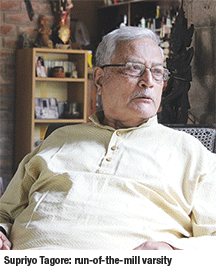
With UGC controlling VBU’s purse strings, the process of homogenisation and standardisation has continued inexorably. In the 1960s and 70s degree courses in arts, science and even commerce were introduced. During the next two decades, computer and technology courses were introduced to keep up with the times. Conventional study programmes and certification which Tagore disfavoured, have become the rule in VBU.
Indeed, the consensus of opinion within the university is that the entire ethos of Visva-Bharati has changed, and the freedom of mind and spirit and joy of learning which Tagore had espoused all his life have all but disappeared from the campus. “Unlike the small learning communities Tagore had envisaged, VBU has become large and unwieldy. The primary and secondary schools he established in Santiniketan are neglected and in decrepit condition because they don’t qualify for UGC funding. Day scholars comprise a large part of school students and primary teachers who are mostly outsiders don’t bother about Tagore’s education ideology. Only the centre of fine arts (Kala Bhavan) and Sriniketan (the rural reconstruction unit) retain some of Gurudev’s vision and philosophy,” says a disenchanted senior faculty member who preferred to remain anonymous.
Dr. Jayati Gupta, former head of the department of English at Presidency College (now Presidency University) and currently professor of English at the West Bengal State University shares some of this anguish. “When it was conceptualised, VBU was far ahead of its time, had an amazing charter and all the potential to develop into India’s foremost and internationally comparable university. But because post-independence India’s somewhat unrefined middle class didn’t share Tagore’s philosophy of education and VBU’s faculty became rootless, in the popular perception Visva-Bharati has become just another university. Nevertheless, its fine arts, music and performing arts faculties are the best in the country, and to that extent, VBU and Santiniketan are abodes of peace with considerable rejuvenation and development potential waiting to be released,” says Gupta.
Undoubtedly VBU retains many of its unique traditions and characteristics which distinguish it from India’s 700 universities. Its literature and language faculties are still among the best pan-India. In Bhasha Bhavan apart from Bengali, Hindi and English, Pali, Prakrit, classical and Vedic Sanskrit, Arabic, Persian and German are taught as are sui generis courses in Zoroastrian and Hindu philosophy, Islamic culture and mysticism of the medieval ages. Cheena Bhavan, established in 1937, still offers Sino-Indian study programmes, respected and valued by governments and diplomats in both countries. Students of divergent nationalities are offered an exclusive one-year integrated course in Indian culture and civilization. Moreover the Central Library, one of the best in the country, houses over 400,000 volumes, 75,000 e-books, and 25,000 journal subscriptions.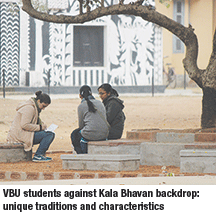
SRINIKETAN (ESTB. 1922), another living example of Tagore’s nation-building attempt sited at Surul (about 3 km from Santiniketan), hosts tribals who are helped to keep alive their traditional skills in batik, leather making, crafts and pottery. The culture and performance arts faculties are as active in Santiniketan as they were in Tagore’s days. Seasonal festivals (each with a scientific explanation behind it) are still celebrated with pomp and fervour on the Visva-Bharati campus with equal participation of teachers and students.
For all these reasons, VBU vice chancellor Sushanta Dattagupta refuses to accept VBU’s glory days are over, and that Tagore’s humanistic dream of a shrine to culture and learning in Santiniketan is unrealisable. “Although there is precious little I can do within the current framework in which I am obliged to operate, I believe that reviving the liberal and experiential curriculum which Gurudev Tagore had envisaged, and infusing it with fine arts and music, will equip our students with the life skills that make well-rounded personalities. On the centenary of Tagore’s Nobel Prize for his exalted ideals and deep philosophical insights relating to education, we are re-inspired to provide our students with curriculums that will transcend bookish knowledge, broaden their minds, build character and equip them to become valued, contributing members of society. That was Rabindranth Tagore’s blueprint for education and his cherished dream,” says Dattagupta.
Ninety three years after Rabindranath Tagore, so far India’s sole literature Nobel Laureate invested the entire cargo of his life’s substantial treasure to establish a global university which would be a synthesis of the classical wisdom, philosophy and spiritualism of India and the orient and the science, technology and liberal humanism of the West, a combination of government apathy, intellectual inertia and middle class materialism has reduced Visva-Bharati University — his passionate dream — to the status of a low-profile provincial institution, renowned for its history instead of its contributions to the expanding global pool of knowledge. In the new millennium when there is greater awareness that runaway advances in science and technology need to be tempered with sciences of the mind such as philosophy, humanism and spirituality, there is urgent need to review Tagore’s educational legacy.
As the centenary year of this potentially great university founded with the noblest aspirations for the unity of humankind draws near, a revived national effort needs to be undertaken to restore peace to the restless spirit of the visionary poet-educator which roams the leafy groves and glades of Santiniketan.
Also Read: West Bengal: Despondent centenary























